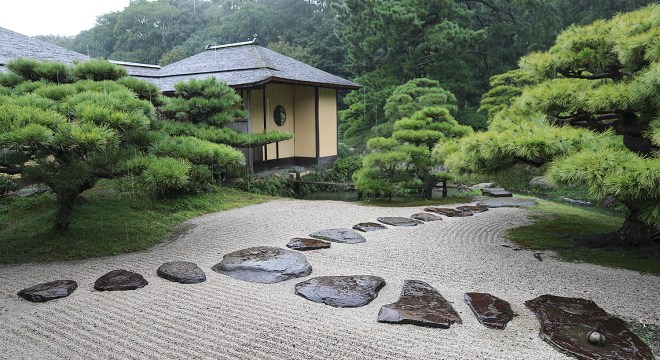
A Rainy Visit to Ritsurin Park




It rained on and off during most of my five-day visit to Shikoku which preceded Typhoon Luca packing 142mph winds and heavy rains. I left just before it was forecast to hit Tokyo on Monday, and had difficulties connecting on line on my last day in Japan. On Saturday morning we were treated to a special treat, a private traditional breakfast featuring delicious local vegetables in an old teahouse in Ritsurin Park. The tokonoma alcove had a beautiful ikebana flower arrangement which was a refreshing change from the TV displayed in the alcove the night before in my hotel room. Only fine treasured items are usually displayed in this special area. I guess some value TVs more than art.




Ritsurin Park took on a misty feeling during the pouring rain as we strolled through the garden with umbrellas and my camera wrapped in a towel. There is a large trained Japanese five-needle pine garden tree in front of the Kikugetsu Tea House near the edge of the main pond. It originally was a bonsai over 300 years ago when the Emperor presented it to the Feudal Lord. Since it was a treasured gift from the Emperor, it was not maintained as a bonsai and was planted in the garden. The garden tree grew and is trimmed yearly and the long horizontal branches are supported with large wooden logs. The Japanese five-needle pine was started from a grafted tree on to Japanese black pine, which has now features exposed roots. I’ve been admiring its beauty for 47 years and delighted to see it each time I visit Ritsurin Park.


Ritsurin garden was started in 1625 by the Feudal Lord and was later transferred to the powerful Matsudaira Clan in 1642 that developed, enlarged and completed the garden design. A descendant, Count Yorinaga Matsudaira was keen for small size bonsai and with his wife developed one of the first, largest and most famous collections of shohin bonsai. He also assisted and supported the establishment of the Kokufu Bonsai Exhibition which began in 1934, held twice yearly. He had a featured display from his collection in every exhibition until his death in the 1940s which his wife continued until her passing in the early 1980s. I feel honored to be the caretaker of one of his original Japanese maple shohin bonsai.

30th Kokubunji Bonsai & Green Festival– Creative Bonsai Displays
Several years ago a local Takamatsu High School began a project where high school girls enrolled in an industrial arts program used bonsai to display their hand made furniture. Both wood and glass were used for their projects. I was impressed with their creativity and there were always a group of proud students with their happi coats answering questions.













Valavanis Bonsai Demonstration


Again, I was honored during this trip to present a lecture/demonstration at the 30th Kokubunji Bonsai & Green Festival. Koji Hiramatsu provided an excellent Japanese red pine which collected by a client of his about four years ago. It is approximately 50 years old and was well established in a training pot and was even tied in for extra stability.

Hiro Yamaji’s son, Takamasa (Taka,) was my assistant for my demo which was translated by Gerald Rainville from British Columbia, Canada, where he operates Shikoku Bonsai Canada. Jerry originally studied with Hiro Yamaji and Koji Hiramatsu’s father in the 1980s. He returned to Kokubunjiu to help with the exhibition.


Taka is currently an apprentice with Minoru Akiyama in Yamanashi, Japan, and returned home to help his family with the festival. Later that evening he left the festival and family to join Mr. Akiyama on their way to Philadelphia to work on the Kennett Collection. He did a great job assisting me and even helped Jerry translate “Sissy Wire” from English into Japanese for my demo, many of the audience chuckled. I look forward to watching Taka develop as a bonsai artist and the third generation of the Santo-en Bonsai garden of Hiro Yamani.


All three of us worked for about an hour to a full house audience who wanted to see what a foreigner could do styling Japanese bonsai. The final adjusted photo of the demonstration tree is my projected future development of the bonsai.

This concluded my short five-day visit to Shikoku Island for the Japanese government tourist bureau to research and promote the wonders of beautiful Shikoku. But, I’ll return to Japan in a few weeks, (after teaching next week in California and the following week in Taiwan) for the Japan Bonsai Taikan Exhibition. Two weeks ago I was teaching in China and last week I was in Washington, DC. And returned home to complete my bonsai classes.

Watch for my article in a future issue of International BONSAI, and visit Discover Shikoku!
http://www.discovershikoku.com


